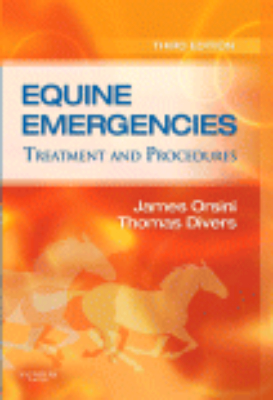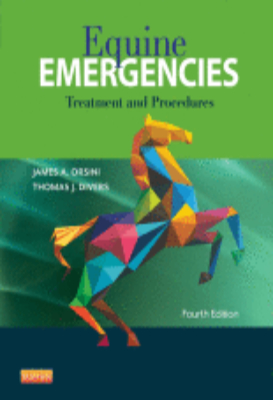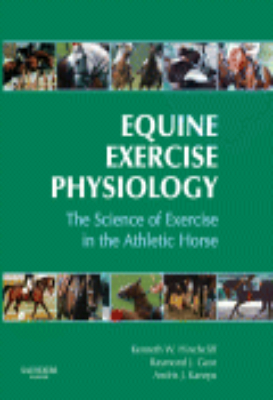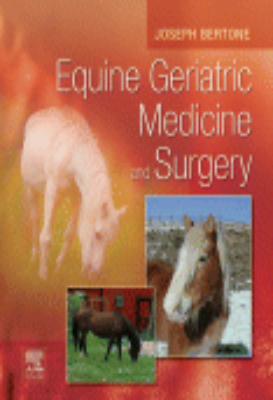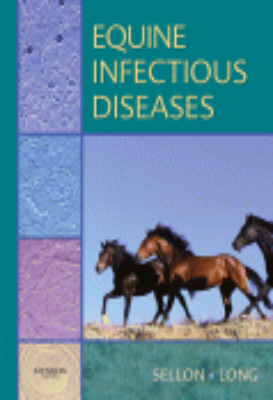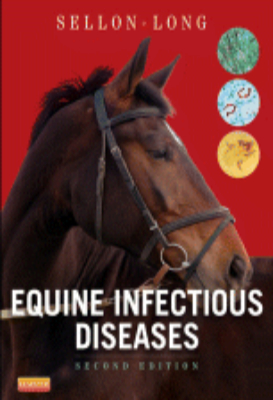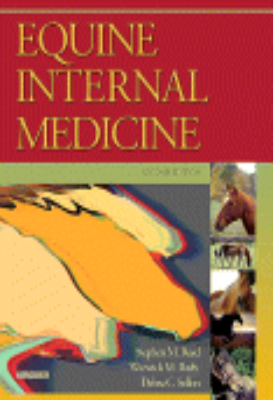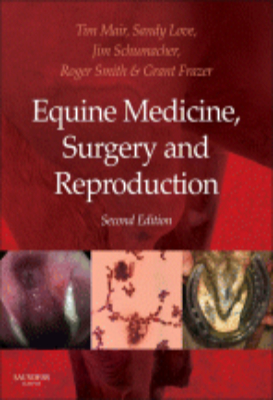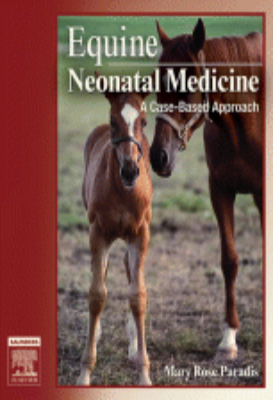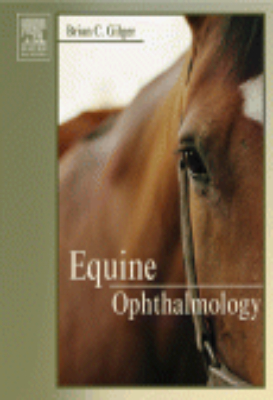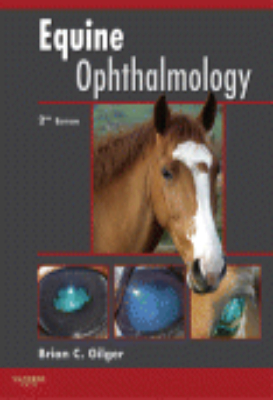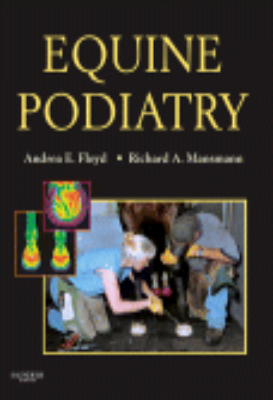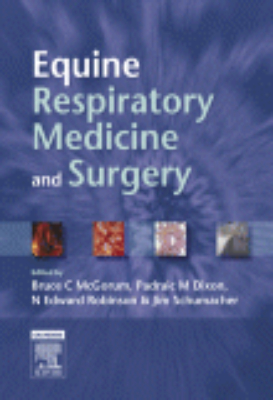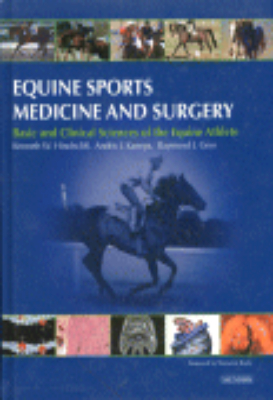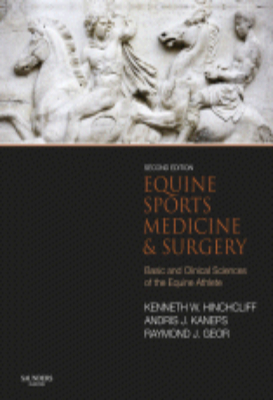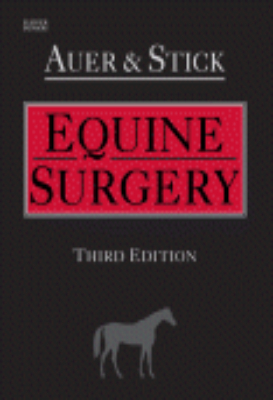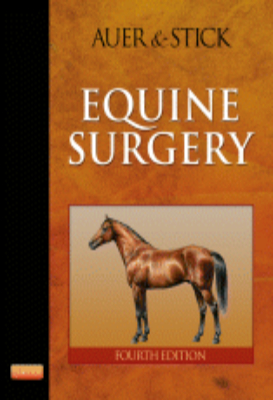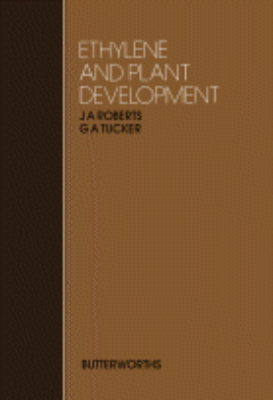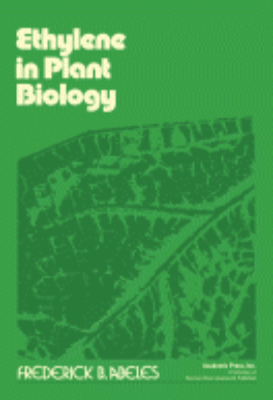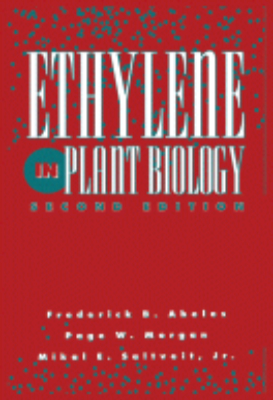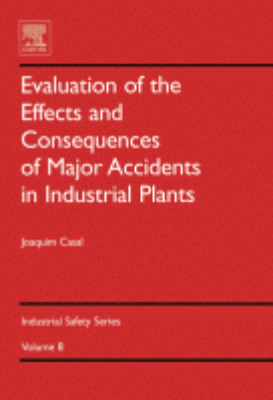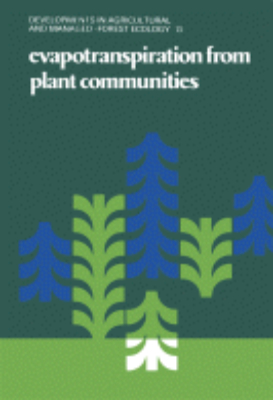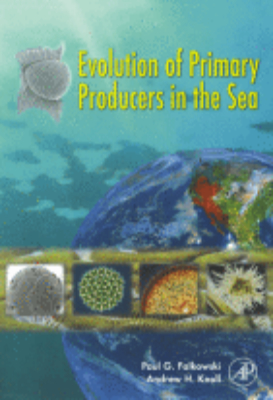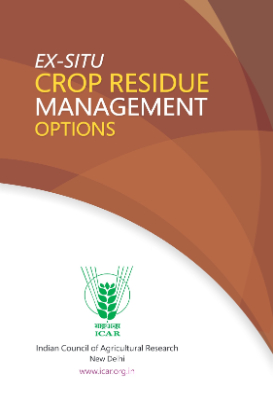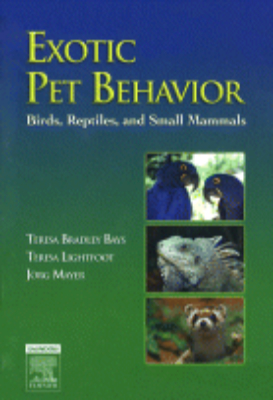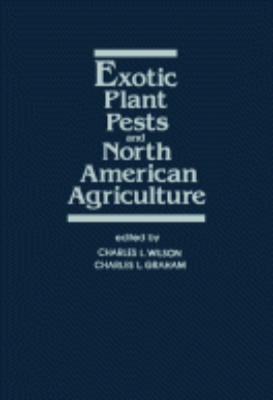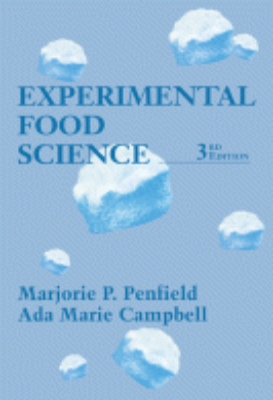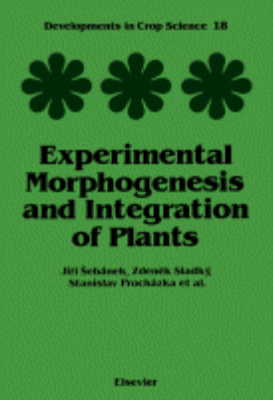ebooks
Equine Emergencies: 2008
Respond quickly and confidently to emergency situations with the only text dedicated entirely to equine emergency treatment. The latest edition of this reliable manual is vastly expanded to encompass a wide range of new and evolving topics in horse care, with thorough, step-by-step procedures for the most effective emergency treatment. Portable for use in the clinic or in the field and presented for the first time in full color, it's your one-source guide for complete equine emergency support.
Equine Emergencies: 2014
Ideal for use in the clinic and in the field, Equine Emergencies: Treatment and Procedures, 4th Edition, offers practical step-by-step guidelines for effectively managing a wide range of emergency situations. Thoroughly updated content keeps you informed of the latest advances in horse care in a portable, convenient format.
Equine Exercise Physiology
Equine Exercise Physiology provides the most up-to-date, in-depth coverage of the basic sciences required for an understanding of the physiology of the equine athlete. This book provides a thorough grounding in the basic physiology of each body system and in particular the responses of each body system to exercise and training. It is the ideal resource for those interested in equine exercise physiology: undergraduate and post-graduate students in exercise science, comparative physiology, biology and veterinary science; veterinary students; horse trainers and owners of sport horses; journalists writing in equine specialty magazines; and interested lay persons.
Equine Geriatric Medicine and Surgery
Interest in equine geriatrics among veterinarians and researchers is on the rise as many horses remain active and rideable well into their twenties. However, as horses age, they develop certain condition that affect their overall health. Equine Geriatric Medicine and Surgery is a thorough and comprehensive text covering every aspect of veterinary management of the aging horse. The text covers many clinical topics like cardiology, dentistry, nutrition and more. Plus, there are a number of chapters devoted to the emotional challenges of caring the aging horse. Many of the conditions commonly associated with old age in the horse such as lameness, weight loss, or poor shedding actually might be treatable or preventable. Equine Geriatric Medicine and Surgery will help veterinarians manage their patients health, and the specially written laymans sections will help educate owners about preventive measures that can be taken to extend the life of their animals.
Equine Infectious Diseases: 2007
Ideal for both practitioners and students, this comprehensive resource covers the diagnosis, treatment, and prevention of infectious disease in horses. Organized by infectious agent virus, bacterial and rickettsial, protazoal, and fungal it includes complete coverage of the individual diseases caused by each type of agent. A section on clinical problems examines conditions such as ocular infections, CNS infections, and skin infections. It also addresses the importance of preventing and controlling infectious disease outbreaks with coverage of epidemiology, biosecurity, antimicrobial therapy, and recognizing foreign equine diseases.
Equine Infectious Diseases: 2014
Ideal for both practitioners and students, Equine Infectious Diseases, 2nd Edition covers the diagnosis, treatment, and prevention of infectious disease in horses. Organized by infectious agent viral, bacterial and rickettsial, protozoal, and fungal it includes complete coverage of the individual diseases caused by each type of agent. A section on clinical problems offers effective treatment for conditions such as ocular infections, CNS infections, and skin infections. Preventing and controlling infectious disease outbreaks is addressed with information on epidemiology, biosecurity, antimicrobial therapy, and recognizing foreign equine diseases.
Equine Internal Medicine
This is the only equine book on the market devoted solely to internal medicine. This problem-oriented book is organised into two primary sections. Part 1 is problem-based focusing on the mechanisms underlying disease and the principles underlying treatment. Part 2 is a body systems approach to common problems. Here individual diseases are discussed in terms of anatomy and physiology, pathophysiology, clinical signs, diagnosis, and treatment. There are special and timely chapters on critical care, diseases of foals, and epidemiology.
Equine Medicine Surgery and Reproduction
The new edition of this introductory-level textbook continues to offer a concise and approachable bridge between student lecture notes and more detailed clinical reference works. All aspects of equine medicine, surgery and reproduction are covered in a single, convenient volume. The second edition has been subject to an extensive revision, with each chapter updated and new chapters added to cover wound management, critical care, anaesthesia and sedation, and diagnostic imaging. While offering key information in an easily and quickly digested format for clinical veterinary students and practising veterinary surgeons, this second edition of Equine Medicine, Surgery and Reproduction will also be relevant to students undertaking equine science degrees, and to professional horse owners and trainers. The wide range of international contributors, highly experienced and all experts in their fields, ensures that the new edition of this popular all-in-one resource remains as indispensable as ever.
Equine Neonatal Medicine
Get expert insight into the latest life-saving techniques and procedures from leaders in equine neonatal medicine. This outstanding textbook and clinical reference takes a case-based approach to the basic pathophysiology, diagnosis, and treatment of disease in the newborn foal, along with neonatal pharmacology, nutrition, assessment, and high-risk pregnancies.
Equine Ophthalmology: 2005
This comprehensive text covers the diagnosis, treatment, and surgery of ocular disorders in horses. The content provides a complete guide to the diagnosis and treatment of equine ocular disorders. With contributions from 21 equine experts from all over the world, this resource is truly all-inclusive. Each chapter features multiple figures, diagrams, tables, and individual disease sections that are organized to assist readers who need a quick reference. The practical nature of the book makes it ideal for equine practitioners, veterinary students, ophthalmology residents, and veterinary ophthalmologists.
Equine Ophthalmology: 2011
With contributions from 18 of the world's leading equine experts, Equine Ophthalmology provides the comprehensive and authoritative coverage you need to diagnose, manage, and operate on ocular disorders in horses. Detailed illustrations facilitate the accurate identification of a wide range of ocular diseases, while up-to-date and easily accessible clinical information helps you decide on the best course of treatment.
Equine Podiatry
This comprehensive text not only covers basic principles of horseshoeing, but also focuses on medical and surgical foot care management. Starting with the anatomy and physiology of the equine foot, this one-of-a-kind book then evaluates the foot, its pathological conditions (including structural, developmental, and traumatic conditions in addition to laminitis), balancing and shoeing the healthy and diseased equine hoof, and ends with a chapter on new directions in equine podiatry, written by cutting-edge researchers in the field.
Equine Respiratory Medicine and Surgery
Equine Respiratory Medicine and Surgery provides the most up-to-date, in-depth coverage of the basic and clinical sciences required for management of respiratory disorders in the horse. The book provides a thorough grounding in respiratory physiology, examination techniques, and reviews each of the medical and surgical problems that may be encountered, organised anatomically and progressing in logical fashion from the upper airways, larynx and sinuses, through to the lower airways, the lungs and diaphragm. The text encompasses investigation and diagnosis of each of the common types of problem, including infections, allergy, trauma, cysts and tumours, and provides comprehensive guidance on both medical and surgical management.Key features include: High quality artwork, including relevant radiographic, ultrasonographic, CAT scan, and MRI images, to aid understanding and diagnosis/ integrated colour photographs throughout A truly international perspective A lucid, accessible pedagogic style to aid rapid reference The highly respected editors have brought together an internationally renowned team of contributors, producing the ultimate reference for veterinarians, students, and professional horse-owners.
Equine Sports Medicine and Surgery: 2004
Equine Sports Medicine and Surgery provides the most up-to-date, in-depth coverage of the basic and clinical sciences required for management of the equine athlete. The unique treatment of exercise physiology and training within a clinical context, together with detailed review of all diseases affecting athletic horses, makes this the most comprehensive text available.The book will provide a thorough grounding in the basic physiology of each body system, and in particular the responses of each body system to exercise and training, that will be separate, but highly relevant to, the succeeding sections on clinical disorders of each body system. The highly respected editors have brought together an internationally renowned team of 50 contributors, producing the ultimate reference for veterinarians, students, horse-owners, and all those involved in the world of equine athletics.
Equine Sports Medicine and Surgery: 2014
This unique resource provides the most up-to-date, in-depth coverage of the basic and clinical sciences required for management of the equine athlete. The unique treatment of exercise physiology and training within a clinical context, together with a detailed review of all diseases affecting athletic horses, makes this the most comprehensive text available. Provides a thorough grounding in the basic physiology of each body system, and in particular the responses of each body system to exercise and training. The internationally renowned team of contributors has created the ultimate reference for veterinarians, students, horse-owners, and all those involved in the world of equine athletics. "a signicant amount of practical information for use in the eld, as well as providing a sound scientic basis for therapy and understanding of the underlying pathology of the horse as an athlete."Reviewed by: John Bowers on behalf of Australian Veterinary Journal, May 2015
Equine Surgery: 2006
The most comprehensive text available on equine surgery, this book prepares the veterinary surgeon for managing each surgical condition by understanding its pathophysiology and evaluating alternative surgical approaches. Explanations describe how to avoid surgical infections, select and use instruments, and perfect fundamental surgical techniques including incisions, cautery, retractions, irrigation, surgical suction, wound closure, dressings, bandages, and casts.
Equine Surgery: 2012
The most comprehensive reference available on equine surgery, this book prepares the veterinary surgeon for managing each surgical condition by understanding its pathophysiology and evaluating alternative surgical approaches. Explanations describe how to avoid surgical infections, select and use instruments, and perfect fundamental surgical techniques including incisions, cautery, retractions, irrigation, surgical suction, wound closure, dressings, bandages, and casts.
Ethylene and Plant Development
Ethylene and Plant Development documents the Proceedings of the Thirty-ninth University of Nottingham Easter School in Agricultural Science, held at Sutton Bonington on 26-30 March 1984. The conference was entitled ""Ethylene and Plant Development"" and included a workshop, organized in conjunction with the Association of Applied Biologists, on the ""Practical control of ethylene in fruit, vegetables, and flowers."" This volume contains a mixture of review and research papers thus giving a thorough coverage on the subject. The workshop reviewed the practical methods and advantages of either applying ethylene to, or removing ethylene from, various commercial products. The rest of the conference dealt with the more fundamental aspects of ethylene synthesis and action during the developmental processes in which the gas is active. Emphasis was particularly placed on the effects of ethylene on gene expression and cell development since advances in these areas may eventually lead to a more scientifically-based control of ethylene levels and action within the plant.
Ethylene in Plant Biology: 1973
Ethylene in Plant Biology focuses on the role of ethylene in plant physiology and the interrelationship between ethylene, fruit ripening, and respiration. It summarizes the physiology, biochemistry, production, regulation, plant effects, metabolism, and mechanism of action of ethylene. This book presents an introduction to basic chemistry of ethylene and available techniques for its sampling and analysis. Then, it discusses the rate, environmental conditions, and reactions involved in ethylene production. Chapter 4 examines the effects of herbicides and hormones, such as auxin, gibberellins, cytokinins, and abscisic acid, on ethylene production. Meanwhile, the next chapter studies the so-called stress ethylene phenomenon in plants. In particular, this book examines the role of insects, temperature, water, gamma-irradiation, and mechanical and chemical stimuli in stress ethylene. The biochemical aspects of ethylene are covered in the subsequent chapters. These include its role in growth and development of plant, phytogerontological activity, role in ethylene synthesis, respiration, pigmentation, and hormone regulation. Chapter 9 presents the activity of ethylene relative to other hydrocarbon analogs and dose-response relationships for a number of ethylene-mediated processes. The concluding chapters tackle the attachment of ethylene to its site of action, including epinasty, root initiation, intumescence formation, and floral initiation. A discussion on the issue of ethylene air pollution is included. This book will be useful to both undergraduate students and professional workers, especially those who have background in plant anatomy, plant physiology, or biochemistry.
Ethylene in Plant Biology: Second Edition 1992
"Ethylene in Plant Biology, Second Edition provides a definitive survey of what is currently known about this structurally simplest of all plant growth regulators. This volume contains all new material plus a bibliographic guide to the complete literature of this field. Progress in molecular biology and biotechnology as well as biochemistry, plant physiology, development, regulation, and environmental aspects is covered in nine chapters co-authored by three eminent authorities in plant ethylene research. This volume is the modern text reference for all researchers and students of ethylene in plant and agricultural science. Key Features. Completely updated. Concise, readable style for students and professional. Contains an extensive bibliographic guide to the original literature. Well illustrated with diagrams and photographs. Thorough coverage of: ethylene and ethephon roles and effects stress ethylene, biosynthesis of ethylene, molecular biology of ethylene, action of ethylene, agricultural uses of ethylene"
Eukaryotic Cell Genetics
Eukaryotic Cell Genetics reviews the state of knowledge in somatic cell genetics. The book begins by discussing the development of somatic cell genetics, focusing on the estimation of mutation rates in mammalian cells, with frequent reference to the use of drug resistance as a selective character. It then considers some of the specific properties of such variants in order to understand their molecular basis. The subsequent chapters examine the properties of specific types of auxotrophic variants; the means by which eukaryotic cells may be reassembled to give rise to viable cellular composites; gene regulation in eukaryotic organisms; and chromosome mapping. The discussions also include differentiation in cultured cells; neoplastic transformation; the modulation of gene expression in cultured cells; mutation induction in cultured cells; applications of cell culture; and the mechanism of cellular aging. This book is intended for researchers in the fields of genetics and molecular biology, nonspecialists interested in what is happening in a very exciting area of biology, and students at the graduate level in cell biology.
Evolution of Primary Producers in the Sea
"Evolution of Primary Producers in the Sea reference examines how photosynthesis evolved on Earth and how phytoplankton evolved through time ultimately to permit the evolution of complex life, including human beings. The first of its kind, this book provides thorough coverage of key topics, with contributions by leading experts in biophysics, evolutionary biology, micropaleontology, marine ecology, and biogeochemistry.This exciting new book is of interest not only to students and researchers in marine science, but also to evolutionary biologists and ecologists interested in understanding the origins and diversification of life. Evolution of Primary Producers in the Sea offers these students and researchers an understanding of the molecular evolution, phylogeny, fossil record, and environmental processes that collectively permits us to comprehend the rise of phytoplankton and their impact on Earth's ecology and biogeochemistry. It is certain to become the first and best word on this exhilarating topic. Key Features. Discusses the evolution of phytoplankton in the world's oceans as the first living organisms and the first and basic producers in the earths food chain. Includes the latest developments in the evolution and ecology of marine phytoplankton specifically with additional information on marine ecosystems and biogeochemical cycles. The only book to consider of the evolution of phytoplankton and its role in molecular evolution, biogeochemistry, paleontology, and oceanographic aspects. Written at a level suitable for related reading use in courses on the Evolution of the Biosphere, Ecological and Biological oceanography and marine biology, and Biodiversity"
Ex-Situ Crop Residue Management
THE Committee on economic analysis of alternative/ex-situ options of
crop residue management likes to express its sincere and whole hearted
thanks to Dr. Trilochan Mohapatra, Secretary, DARE and DG, ICAR for his
foresight in formulating concepts and ideas for ex-situ management of crop
residues, for instituting this Committee and further for providing his
valuable inputs at various stages for finalizing the "Ex-situ Crop Residue
Management Options" document.
The Committee also extends its sincere thanks to the AS (DARE) and
Secretary (ICAR), Secretary, Ministry of Power, and Secretary, Ministry of
Petroleum and Natural Gas and Director, ICAR-NIAP for valuable guidance
all through for drafting the recommendations.
Thanks are also due to all the members of the High Level Monitoring
Committee on In-situ Crop residue Management Central Sector Scheme,
Director ICAR-CIAE, Bhopal, Dr. KC Pandey, Project Coordinator of AICRP on
Energy in Agriculture and Agro Industries, Dr. Nalini Ranjan Kumar, Principal
Scientist, ICAR-NIAP, Dr. S.S. Sooch, Principal Scientist (Renewable Energy
Engineering), PAU, Ludhiana, Dr Mukesh Jain, Assistant Professor (FMPE),
CSHAU, Hissar, Dr. Panna Lal Singh, Principal Scientist, Agricultural
Engineering Division, ICAR for their outstanding support and cooperation
during the process of discussions and in finalizing the recommendations.
Member Secretary of this Committee Dr. Kanchan Kumar Singh, Assistant
Director General (Farm Engineering) is appreciated, by the rest of the
Committee, for his strenuous efforts in collating the information and drawing
a conceptual framework that formed the basis of our discussions and for the
overall coordination in formulation and finalization of the recommendations.
Exotic Pet Behavior
In addition to coverage of all normal behavior patterns -- sensory, communication, social and antisocial, reproductive, eating, and elimination -- this resource helps you identify medical implications of abnormal behavior, pain-associated behaviors, and effects of captivity. Client education handouts provide important information about caring for a variety of avian and exotic pets.
Exotic Plant Pests and North American Agriculture
Exotic Plant Pests and North American Agriculture examines the threat posed by exotic pests introduced to North American agriculture. It considers the impact of introduced pests on humans, and it highlights the need for intensified research efforts and international cooperation to prevent further introductions. Organized into 17 chapters plus an epilogue, this volume begins with a historical overview of pest introductions, including insects and mites, and possible introductions in the future. It then discusses the impact of introduced weeds in North America; ecology and genetics of exotic species; how to detect and stop pest introductions; and research on exotic insects, plant pathogens, and weeds. The reader is also introduced to the use of exotic natural enemies for biological control of exotic pests, prediction of potential epidemics caused by exotic pests, insurance against exotic plant pathogens, and international cooperation on controlling exotic pests. Scientists, plant pathologists, ecologists, and those working in academics, government research laboratories, and regulatory agencies will benefit from reading this book.
Experimental Food Science
This textbook presents the scientific basis for understanding the nature of food and the principles of experimental methodology as applied to food. It reviews recent research findings and specific technological advances related to food. Taking an experimental approach, exercises are included at the end of each chapter to provide the needed experience in planning experiments. Emphasizing the relationships between chemical and physical properties, basic formulas and procedures are included in the appendix.

